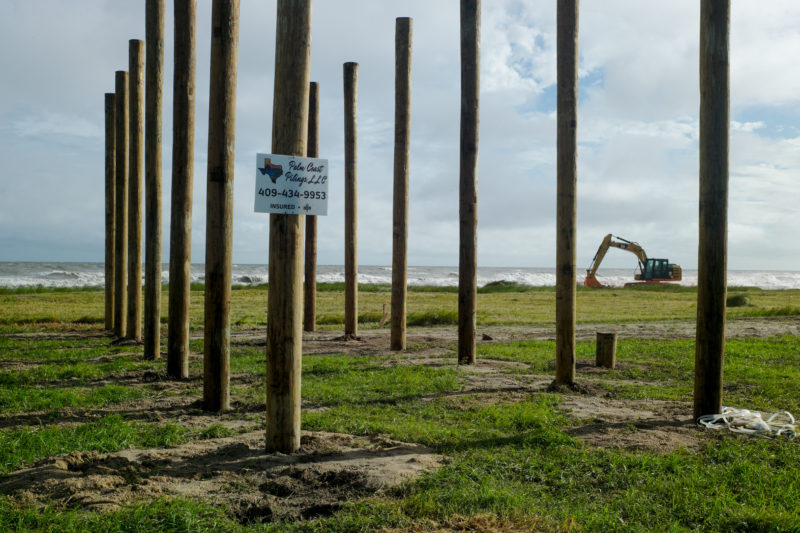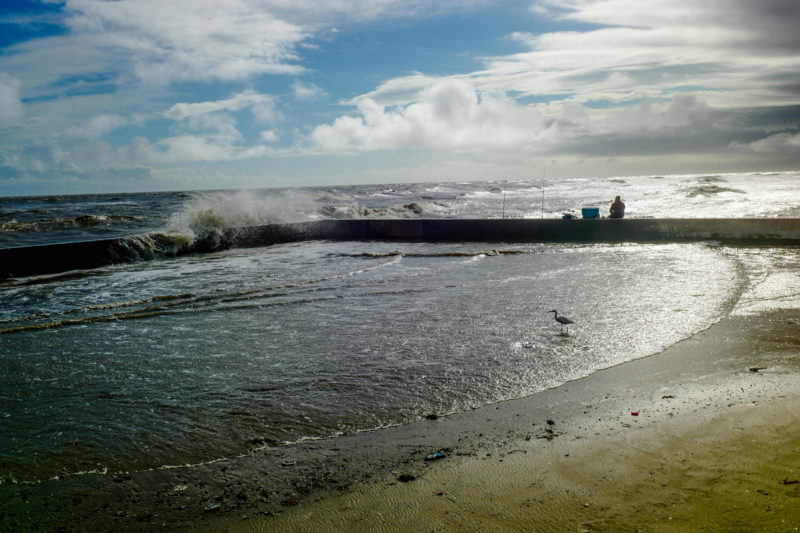After Devastating Storm, Texas Island Flooded by Development
By Scott Squires
Photography By Scott Squires
Reporting Texas

Twenty-foot high wood pilings are sunk into the ground for new homes in Crystal Beach. The pilings raise houses above the 100-year floodplain, protecting homes from storm surges and hurricane-force swells.
CRYSTAL BEACH – The locals at Hardheads exploded into jubilant hoots and hollers as the Houston Astros won another playoff game in their march toward a first world championship. Weathered grins, stretched across faces crinkled from years of squinting in the salty air, beamed in the dimly lit bar. Spirits were high, even after another deadly hurricane season on the Texas coast.
After a win like that one, it was easy to forget that nine years ago, Hurricane Ike nearly wiped Crystal Beach off the map. In 2008, Ike decimated this unincorporated town on Texas’ Bolivar Peninsula, destroying 90 percent of the town’s beachfront homes. Only a few buildings survived.
“I lost everything in 2008,” Beaumont native and Crystal Beach resident Sonny Mitchell said.
Pictures after the storm show Crystal Beach swallowed by the sea. Gray and brown with upturned sediment, the beach was strewn with debris—soaked drywall, two-by-fours and porcelain toilets littered the oceanfront where homes once stood. There was little vegetation left on the peninsula to speak of.
“Until you have lived it, you can’t appreciate the devastation,” Mitchell said.
But Crystal Beach bounced back. Today, high tide laps just feet from scores of candy-colored vacation houses on 20-foot wooden pilings. Rental properties offer sea views to vacationers and the wealthy Houstonians who build second homes here.
As coastal towns such as Port Aransas and Rockport seek to rebuild after Hurricane Harvey’s devastation, the story of Crystal Beach offers hope—and warning— about the increasingly risky endeavor of building on barrier islands along the hurricane-prone Texas coast.

A large home, still under construction, towers above the beach just feet from the shoreline in Crystal Beach. “It’s a second home,” real estate agent Luz Gray said. “The owner lives in Beaumont and built it for his daughter, Clearly, he has no aversion to spending over $500,000.”
After Ike, Crystal Beach gentrified despite the threat of rising sea levels and powerful storms. When property values plummeted in the wake of the hurricane, developers bought up land at a fraction of what it had been worth just a year before. Since then, the total tax value of real estate has quadrupled.
Mitchell, like many others, took advantage of the low prices.
“I bought some land for $35,000 or $40,000 that should have been $80,000 the year before,” he said. Mitchell built four homes in Crystal Beach after Ike.
In the three years afer the storm, Galveston County issued nearly 1,000 new building permits in Crystal Beach. The average value of new construction increased almost 600 percent.
“Our entry level housing now is around $200,000,” Cobb Real Estate agent Luz Gray said. “It used to be that you could buy a $60,000 house, fix it up and make it cute, sell it, and move up. There’s not much of that left.”
Today, almost 1,300 homes in Crystal beach are valued over $200,000. There were only 250 before Ike.
Located about 100 miles southeast of Houston, Crystal Beach began I the 1950s as a quiet fishing community. Back then, houses were “basically old fish camps,” one-room houses with no air-conditioning or glass windows, Mitchell said.
Today, the houses, and building codes, have changed. Homes in Crystal Beach are built on 20-foot pilings sunk four feet into the ground and are outfitted with storm-proof windows and all the modern amenities.
As the quality increased, so did prices.
“I remember a beachfront lot in 1995 that went for $25,000. It’s now worth $250,000,” Mitchell said.
Like many communities on the Texas coast, Crystal Beach is in a federally designated high-risk flood zone. Unless they pay in full at the time of purchase, all homeowners in Crystal Beach must carry flood insurance.
Federal subsidies make the flood insurance relatively cheap. While cheap insurance gives people peace of mind, it also incentivizes development in high-risk areas.
At the same time property owners scramble to rebuild after a storm, cities and counties rush to recoup their property tax base— a major revenue source for local governments. In 2008, before Ike hit, the total appraised property value in Crystal Beach was around $400 million. Ike slashed that number by more than half. Today, total property value is more than $830 million.
After Harvey, the pricetag for Port Aransas’ devastation is expected to be even worse. The city’s tax base is expected to plunge from $2.9 billion to $1.6 billion next year, producing an almost 50 percent drop in its total tax revenue, Mayor Charles Bujan said.
The need to recoup that money puts hurricane-damaged cities in a bind. When people lose their homes, they often don’t come back. When fewer homeowners pay property taxes, the city must increase its tax rate or downsize.
In Rockport, where Harvey made landfall, increasing taxes “would be unconscionable,” Mayor C.J. Was said. “You just can’t do that in a community like mine.”
Rockport suffered the full force of Harvey’s Category 4 winds. City officials estimate 30 to 35 percent of the city will never be rebuilt.
Changing environmental conditions will also be a challenge for Port Aransas and Rockport as they rebuild.
Like Port Aransas, Crystal Beach is on a barrier island. Scarcely more than a sandbar jutting out from the Texas coastline into the Gulf of Mexico, the Bolivar Peninsula shields Galveston Bay and the Port of Houston—home to some of the country’s largest petroleum refineries—from storm surges.
Barrier islands are formed by sedimentary deposits from inland water systems such as rivers and bays, often over the course of 5,000 to 7,000 years. But the Bolivar Peninsula is relatively young, according to coastal sedimentary geologist Tim Dellapenna, who teaches marine science at Texas A&M. Dellapenna also owns a house on the peninsula.
“Bolivar is a very low-relief peninsula formed within the last 2,500 years,” he said. “There are places you can dig down less than a foot and hit water.”

A man fishes from Rollover Pass, a popular fishing spot on the small channel that connects the intercoastal waterway with the ocean between Crystal Beach and Gilchrist.
At the peninsula’s most southern point, waves break just a few feet from the gravel shoulder on State Highway 87. In town, water collects on roadsides and in parking lots after it rains—there is no natural drainage.
Today, the Bolivar Peninsula is shrinking from both sides. Sand is no longer being deposited from the bay side at the same rate it once was. At the same time, sea levels are rising, removing even more sand from the system, according to Dellapenna.
Large hurricanes rapidly speed up that erosion.
“During Ike, we saw the equivalent of 150 years of beach retreat in just a few hours,” Dellapenna said.
That erosion, along with what scientists expect will be stronger storms in the future, make building on barrier islands increasingly risky. Dellapenna thinks developers downplay, to a great extent, the long-term risk of stronger storms and retreating beachfront.
“The argument that we should just push our development back 25, 50, or 75 feet from the shoreline is just crazy,” he said.
Dellapenna believes that no place on the peninsula will be immune to changing environmental conditions. The peninsula is less than a mile wide at most points, and there is no higher ground that won’t be affected by stronger storm surges and rising sea levels.
“It’s not that the peninsula isn’t habitable,” he said. “But if we want to be good citizens, we need to be responsible about where we buy.”
Still, the peninsula’s beauty will always attract new residents.
Despite the environmental risks, Gray said the real estate market is steadily growing — Cobb had 108 houses listed in early December — as people continue to flock to Crystal Beach. Yet it still feels wild. Storks and egrets nest on the intercoastal side of the island, where marshy wetland makes development mostly impossible.
“I think the tradeoff is the luxury of being able to walk down the road and be on the beach,” Gray said. “You have to weigh that with your fear level.”
But fear quickly fades, just like memories from the last big storm.
“We’re creatures of short-term memory,” Mitchell said. “But you know, when it’s something you love that much, you’re willing to take the risk.”